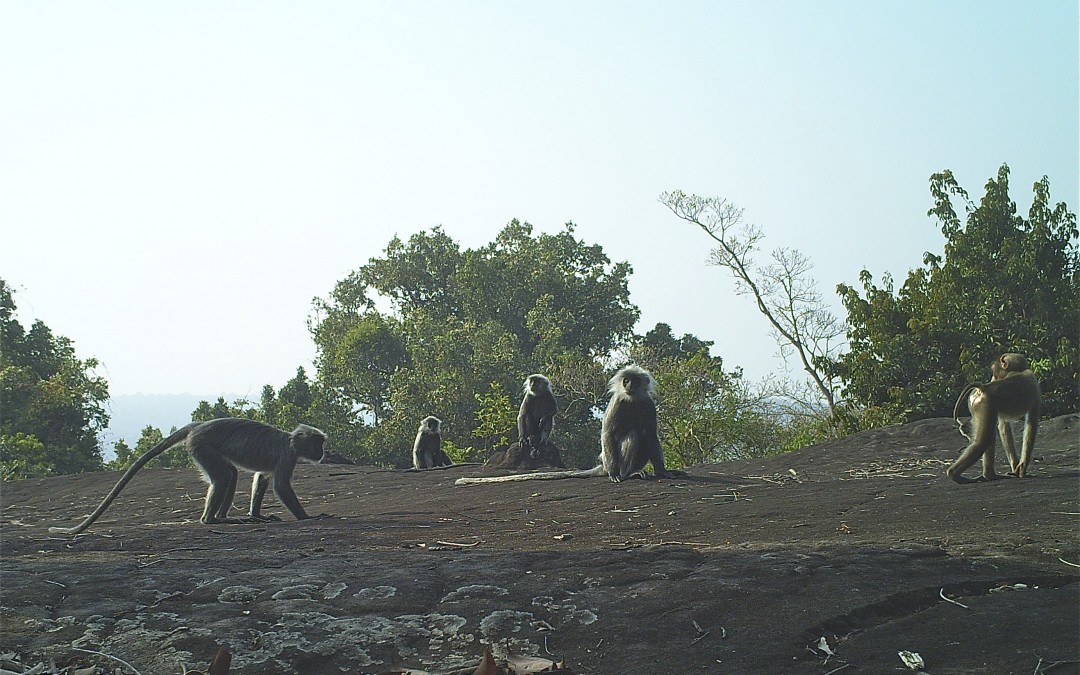
by Nick | Jan 4, 2021 | Blog, Hike
A Kulen Mountain Adventure
Our quest was to seek out the Silver Langur in the forests of Kulen Mountain and whatever other wildlife came our way.
‘Nick I’ve been to Corbett, Kana and Tadoba in India. The Serengeti, The Okavango, etc in Africa, but I don’t expect much.’ Hmmm – no pressure then, I thought. Kulen’s steeped in historical significance as the birthplace of the Angkorian Empire with some amazing relics hidden in the forest. There is wildlife including the fabled langur but it’s not, I hesitated, quite in the same league. ‘No worries, no worries,’ muttered John, our guest for the adventure.
Our next hurdle was the army who suspiciously studied our van, even a barang (foreigner) couldn’t need that amount of stuff for one day on Kulen, eventually they let us past the toll. Safely ensconced in the ramshackle Ministry of Environment (MoE) HQ, the different strands of expedition started to come together beginning with strong black Vietnamese coffee from the stall opposite. After the usual pfaff we set off, striding through the forest with Mr Nai our MoE ranger and dog, she hadn’t got a name.
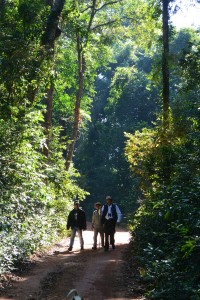 Setting off on The Kulen Trail with Buntha, Nai & John
Setting off on The Kulen Trail with Buntha, Nai & John
It was a lovely walk shaded from the sun by the dark green canopies of tall trees still flushed with rain. As we passed Phum Thmei (lit; new village), the stony ground had little moisture so the mixed evergreen gave way to a warmer shade of dry deciduous forest. It was a beautiful morning, the hot sun shining in a blue sky cooled by winds from the North. The humidity had plummeted and sweat vaporised while doing its job.
Dog had stuck with us, prancing with excitement at the slightest whiff of wildlife, which didn’t exactly help our chances of seeing any. She also had a habit of rolling in whatever stagnant liquid we passed by though there was no way she was going near the nice clean cool clear streams we had to cross, so we smelt her presence as well as heard and saw it.
The Sra Domrey was every bit as magical as always. A two-thirds life size elephant carved out of the rock surrounded by three slightly doubtful lions and a distinctly dubious Nandi the bull.
 Sra Domrey a VIV century Hindu carving
Sra Domrey a VIV century Hindu carving
We let the sense of mystical spirituality soak into our souls as we munched Dean’s sobu noodle salad.
Inexplicably the monks beside the bat cave were clad in fake leopard skin as we passed by a little unsure as to the appropriate etiquette for the situation and entered into the dark smelly dampness. Small bats stirred in the powerful beam of my torch and forayed across the kitch gilt of a Buddhist shrine. More kitch in the form of golden Buddhas, silver stupas and white concrete elephants at Wat Preah Kraal, perched on the crest of a hill with views back over the plains of Siem Reap Province to the Tonle Sap Lake.
Downhill all the way to our campsite where Kuong, our van driver and Chomran from the local village had done us proud and chosen a stunning location perfectly placed above the banks of the fast flowing Kulen River. John’s tent was up and a kettle boiling on the campfire. With a sigh of contentment we drank our tea and ate adventure bars.
The water was cool, deep and invigorating after our long walk. As dusk descended dinner was served, a duck casserole courtesy of Miss Wong with vegetables and rice cooked by Chomran followed by fruit salad.
The trees towering above us appeared vast in the dim light. We caught glimpses of a star studded night sky in between the branches. Dog, who was actually very sweet, was still with us but sensing the seriousness of our quest as we set off on a night walk, kept quiet as our torch beams played through the forest in search of it’s tenants. We walked all the way to the Bat Cave keeping our voices to whispers as we anticipated what we might meet. Are there still leopards on Kulen? I thought, but to no avail.
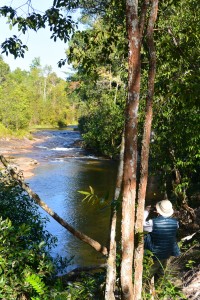 Our Campsite beside the Kulen River
Our Campsite beside the Kulen River
A couple of sleeping birds concluded out watch list. A scratching sound coming from the ground intrigued me until I shone my torch over a troop of termites marching through the leaves. There were spiders of course but no langurs. The forest magical and mysterious at night was reward enough for our efforts.
John could keep his cot and safari tent, my view of the stars shining bright in the clear sky was more than compensation for the slightly strange angle I lay contorted by the hammock and anyway what were Valium for.
The next morning when we woke the coffee was brewed and the table laid. It was a champagne day. We were in no particular hurry, content to eat fruit, sip coffee and watch and listen to the clear water rushing over the rocks below us.
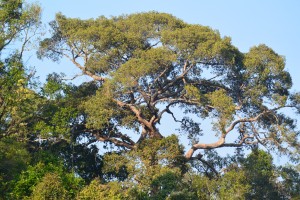 A forest giant
A forest giant
The Langur Trail is a lovely walk, winding its way under a leafy roof many metres above. The Bat Cave marks the beginning of boulder forest, fantastical formations of sandstone the size of houses. One such known as Mushroom Rock afforded views over what appeared as an unbroken wooded valley. Birdsong rang, squirrels barked and insects of every imaginable shape and form fluttered, flew, crouched, quivered and hung but the langurs remained resolutely reclused.
We’d made it back to where we started from, Preah Ang Thom for another cup of muddy Vietnamese coffee and road kill chicken (so named because its flattened to facilitate cooking over the charcoal fire). John went to look at the linga and reclining Buddha with Buntha while I arranged our pick up with Kuong.
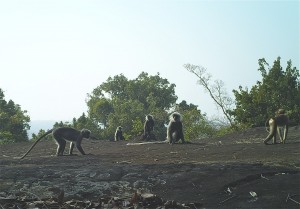 Mushroom Rock in the boulder forest (actually taken by camera trap capturing not only the Silver Langurs but also Pig-tailed Macaque)
Mushroom Rock in the boulder forest (actually taken by camera trap capturing not only the Silver Langurs but also Pig-tailed Macaque)
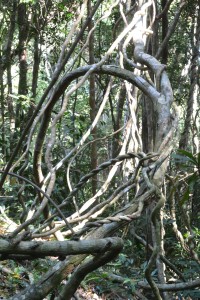 A forest of lianas on the way to Preah Ang Chup
A forest of lianas on the way to Preah Ang Chup
Phnom Kulen was an isolated island until the beginning of this century when the road was built. A set of steep steps up to Preah Ang Chup was the only way up before and now our route on our final leg of the Kulen adventure. The more times I walk the different trails the more identity they assume. One is not like another but it’s beyond my ability to describe the difference. Suffice to say our last 5km was not the same as where we had been before and fuelled our excitement and enthusiasm to the end. Who needs langurs.
Indochine Exploration organises day trips and overnight expeditions (or longer) to experience the forest and its wildlife, including langurs – sometimes. Either on foot or on challenging mountain bike rides.
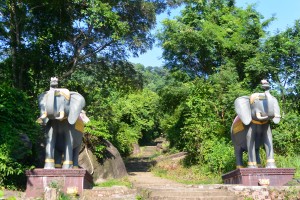 The steps up to Preah Ang Chup, the only entry point to Kulen until early 20th century (compare the current concrete domreys with their Angkorian cousin in the forest)
The steps up to Preah Ang Chup, the only entry point to Kulen until early 20th century (compare the current concrete domreys with their Angkorian cousin in the forest)
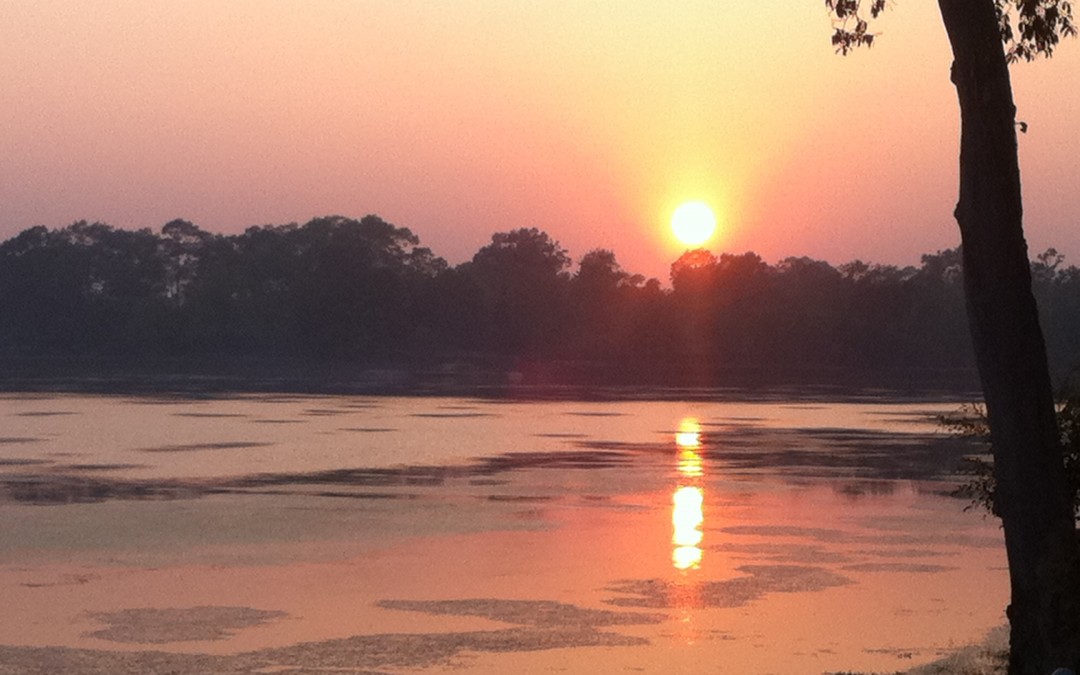
by Nick | Dec 15, 2020 | Angkor, Blog, Hike
Ngin and Nicola’s Temple Hunting Saturday Morning Adventure
An essential Large Little Red Fox latte while Loklak snapped at a French lady then into Panya’s tuktuk for the ride to Phnom Bok.
Panya had the unnecessary ability to find every pothole on the admittedly disintegrating road to Pradark. At Phnom Bok we were greeted with an after party dance party. A wall of speakers sent a reverberating thud up the mountain as we set off through the forest in search of temples.
It’s hot work chasing temples in the woods so Loklak, who remembered the trail from his walk with Emma, a posh dog – charged off to the lake on the other side and was splashing amongst the lotus leaves by the time we arrived.
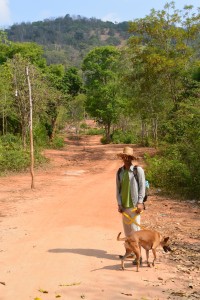 Loklak checking out the temple trail
Loklak checking out the temple trail
The road runs along a raised bank beside the lake, which suggests it was an Angkorian reservoir. Half way through April and about as dry as it gets, it had shrunk to a quarter of its rainy season area. Manus suggested kayaking when it is full.
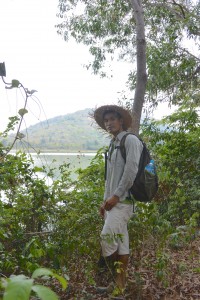 Manus framed by Phnom Bok and it’s lake
Manus framed by Phnom Bok and it’s lake
It wasn’t very difficult, there was a sign but Manus was very proud to have seen it and to be fair Buntha and I had passed by many times oblivious to the little temple that lay about fifty meters from the road
We crossed the empty but still green moat to a central mound and three laterite towers with a looted lintel over the doorway.
The temple was built in the 13th century by a Brahmin priest and intriguingly lies at the corner of two Angkorian reservoirs and a sluice to control the water between them.
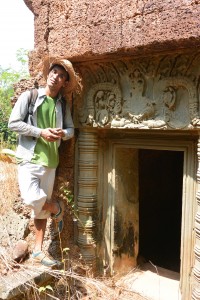
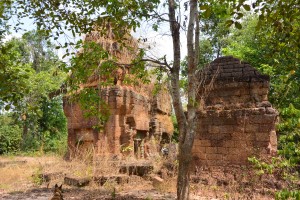 Prasat Toh
Prasat Toh
Apparently the moat wasn’t completely empty. Loklak had found a muddy wallow and ran out the same colour as a wet water buffalo then rolled in the sand and became a fantastical demon from an Angkorian legend.
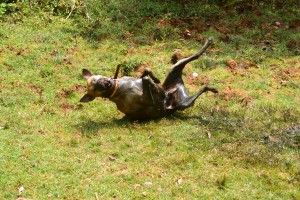 Angkorian demon (left) and Oxcart (below)
Angkorian demon (left) and Oxcart (below)
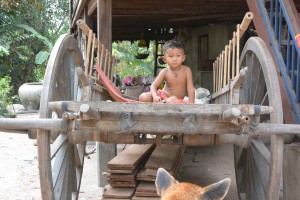
We walked into the village of Phum Samre near Banteay Samre.
A small boy sat on an oxcart and asked for a hopeful dollar, a sugar palm juice collector had two full pots suspended from a pole over his shoulder and wet jeans so low you could almost see his linga.
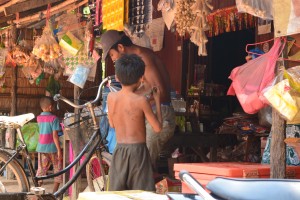 Phum Samre Market
Phum Samre Market
Sticky rice wrapped in banana leaves from the little market and sugar palm juice from the man with the wet jeans, Manus knew him. They’d been in a movie together. I’m waiting for it to make the multiplex in Phnom Penh.
Past the village the houses were bigger, the taller trees and pineapples grew in the filtered sunlight.
Loklak was getting hot and with a loud sigh punctuating his panting collapsed in each thicket of shade we passed.
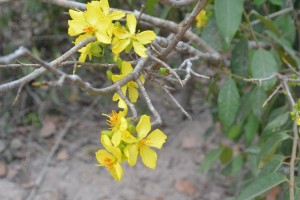 Chinese New Year Flower
Chinese New Year Flower
We turned left instead of right to look for the temple Mr Heng our taxi driver had told me about. In front of us lay baking brown rice paddy’s on what felt like the hottest day of the year. A welcome relief when we entered the gloom under the tall trees near Wat Pradark and a spooky trail between burial mounds strewn with forlorn streamers.
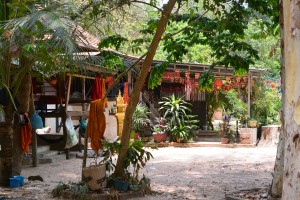 Pradark Pagoda
Pradark Pagoda
A boy monk told us where the temple actually was but first the pagoda pool for another Loklak wallow watched by a frog on a lotus leaf.
A lady wrapped in a wet kroma pointed and in the hundred degree heat we came upon the archaeological excavation of Prasat Kamnap, stepped trenches showed the extent of the structure but gave no secrets away such as why was it buried*
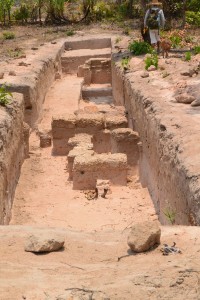 Prasat Kamnap
Prasat Kamnap
*I later found out that a dig had unearthed Sanskrit inscribed stele from what had been an Angkorian monastery, once the secrets had been gleaned in accordance with archaeological practise they were reburied.
We stopped at a stall for Loklak to slurp water from Manus’s cupped hands but that didn’t last long so Loklak beyond caring got carted like a sack of rice until we left the hot red earth road.
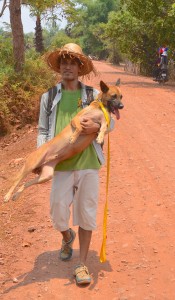
We followed a path under tall sugar palm trees between paddy fields until we came on a woman sluicing herself under a pump. Manus asked if he could sluice Loklak instead and ladled water over the hot dog
 Rehydrating Loklak
Rehydrating Loklak
Ripping my scalp on a projecting thorn we made it through for Loklak with a last gasp to get to the muddy waters of the shrinking baray where he sat with an expression of ‘no more’ across his face.
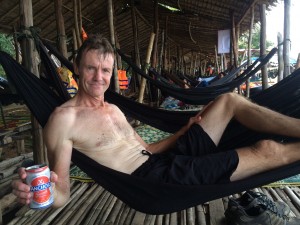 A beer beside the baray
A beer beside the baray
Our final obstacle was a belt of thick vegetation around the West Baray where Panya might be waiting, and our lunch of road kill chicken, rice and most currently appealing cold Cambodia beer.
Something was not quite right? A tough countryside dog gasping his way through a Saturday morning stroll, while the only concern of the admittedly sweat soaked barang was a cold beer. Manus of course was oblivious to the exercise and played games on his phone.
He went to find our lunch while Loklak and I sat amongst the post Khmer New Year debris on the banks of the baray and watched the buffalo bathe. Or at least I did, Loklak had summoned up enough energy to steal a fish head from a small boy then growled when the boy tried to get it back. He ran screaming to his daddy and I looked the other way.
Indochine Exploration would love to take you on a hiking or cycling temple discovery adventure along the paths described in this blog
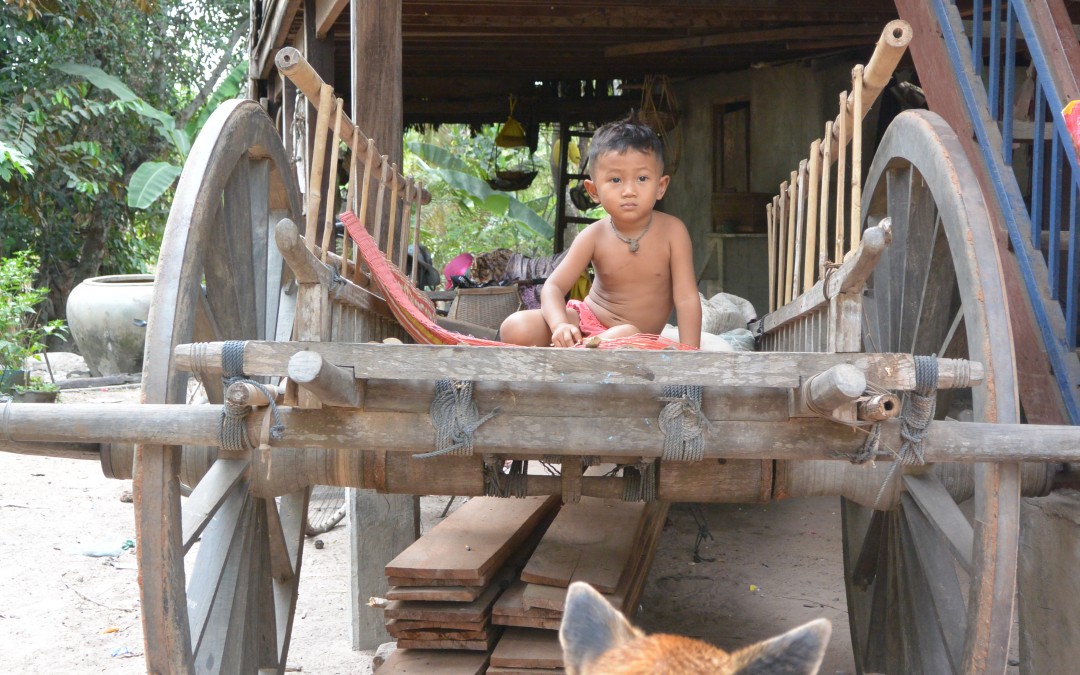
by Nick | Nov 3, 2020 | Angkor, Blog, Kayak
A million miles from the dusty city center and the tour buses jamming the road to Angkor lies the ancient lake of Boeung Ta Neue. Our mission that morning was to discover if this was a kayaking adventure or just a paddle on a large pond.
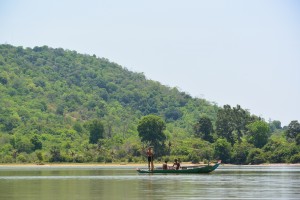 Lake Ta Neue
Lake Ta Neue
The lake lies at the base of Phnom Bok, a 250 meter hill that looms large over the surrounding countryside and a reference point for our cycle rides, hikes and now we hope kayaking. To give you a flavor of all three I’ve taken a bit of poetic license and combined our adventures together.
Our story starts and finishes in Pradark as so many do, we later found out. Pradark for those who haven’t been there is a crossroads with a market on one side and restaurant (loose description) shacks on the other selling rice noodles with fermented fish Khmer num ban chok. We started our bike ride on the old road that leads to Pradark Pagoda, a wat shaded by tall trees protected by the monastery.
 A monk’s house at Pradark Pagoda
A monk’s house at Pradark Pagoda
Cycle left from the well by the lady washing her breasts, continue through scratchy bushes and there in front of you is the excavation site of Prasat Kom Nat. Eleven hundred years ago this was a hermitage for monks and place to store the Sanskrit encrypted stellae that recorded the history of the Angkorian Empire including how the king happened to be feeling that day.
 Prasat Kom Nat
Prasat Kom Nat
Crunching rice stubble we paddy bashed back to the shady path that runs along the banks of the East Baray. The ancient reservoir is a perfect rectangle 12km long by 2km wide once brimming with water. Now it’s a fertile patch of irrigated land, where multiple crops of rice shine bright green the year round.
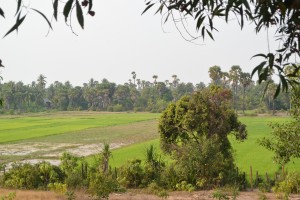 View of the Baray from the East bank
View of the Baray from the East bank
The Village of Pum Samre is built on either side of the path where we cycled, that is until we reached a wedding. A tent had been erected over the dirt track and a bank of speakers piled ominously in front of the family’s house. We rode between the tables of spangled women in tight nylon dresses and drably clothed men in ill fitting long sleeve shirts and trousers, who oblivious to our bikes continued to toast with Angkor beer and ice. And wash down whatever offal was on the wedding menu that day.
Village life was on show; buffalo snorted, cows chewed, dogs barked, children shouted hello then goodbye, adults the customary greeting ‘mow pi na?’ Where do you come from, moto-dops and bicycles, beautifully crafted oxcarts and the mechanical kroyun or tactors that are replacing them.
 The village of Pum Samre
The village of Pum Samre
Wooden houses built on stilts to provide shelter from the rain, sun and insects. Mango trees to give ripe mangoes, coconut palms – well its obvious and sugar palms, you’ve guessed it sugar and the wine that ferments in plastic bottles hung beneath the flowers, reached by a bamboo ladder tied to the side of the tree.
Ahead of us lay the lake that laps up to the base of Phnom Bok, or at least it will when the rains come, but first Prasat Tor. We nosed through the thickening vegetation that cloaks the temple. Three laterite towers on a raised mound, where shaded by a leafy tree our table will be laid for our guest’s lunch (will because we haven’t done it yet).
 Prasat Tor
Prasat Tor
Suitably fortified by our imaginary repast we (will) find our kayaks ready on the lake shore
– what happened actually;
A barang (foreigner) on a dirt bike with a big bag is reason enough to abandon whatever you are doing. When the big bag turns out to be a boat – our kayak, it becomes a day to remember. So by the time we were ready to start we had a launch committee. The fishermen in underpants stopped casting their nets in wonderment while those submerged to their noses turned to stare.
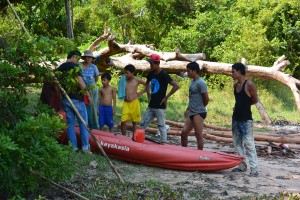 The launch committee
The launch committee
Clad in a mantle of green forest the mountain dominates the lake. At its base cows grazed and fishermen returned with their catch, from which the women make prahoc (fermented fish). Ladies cut spiky leaves to weave baskets and buffalo munched on water hyacinth.
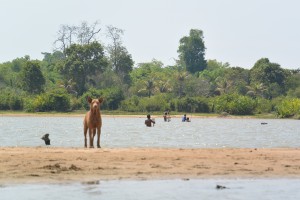 Cast net fishermen (and a dog)
Cast net fishermen (and a dog)
We set off to find the West channel , a bamboo fishing fence. The North channel, clogged by mats of impenetrable water hyacinth and the South Channel, no water. So we paddled back to where we’d started. In a few months the lake will have swelled opening up the rivers and canals for us to explore and paddle to our pick up point.
Postscript;
Lunch was back at Pradark where we’d started with Num Bang Chok and Angkor beer. Mixing the required vegetation into the coconut noodles, first a white taxi and a fat driver who’d just ordered his noodles and coconut when a second blue taxi screeched to a halt beside our table. The driver of the second taxi jumped out handed some dollars to the fat driver, while a lady sitting in the back seat pulled a barely conscious girl out of the car and carried her across to the white taxi, which sped off before she could close the door.
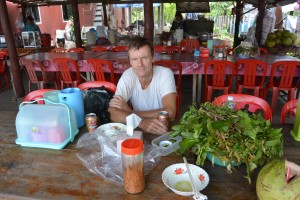 Num ban Chok in Pradark
Num ban Chok in Pradark
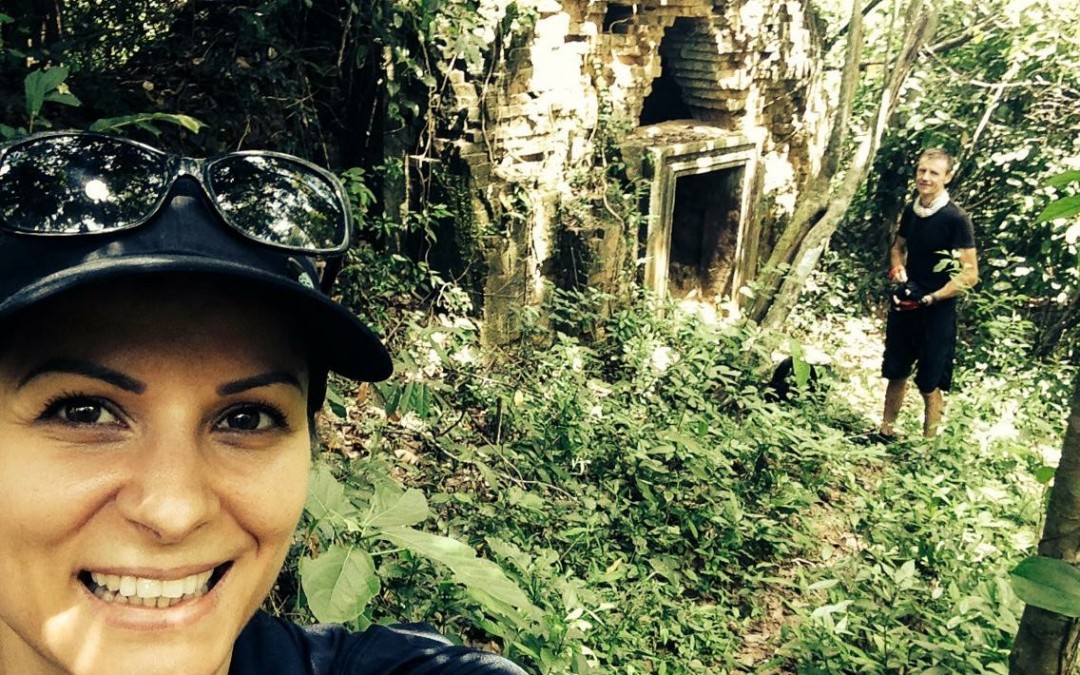
by Nick | Oct 8, 2020 | Angkor, Bike, Blog
Temple Hunting in The Angkor Countryside
The countryside surrounding Angkor is one of paddy fields and sugar palms. Dotted with small villages of traditional wooden houses built on stilts surrounded by fruit trees. Trapaeng or pools, vast ancient baray or reservoirs and the rivers and channels that still connect the ruins of ancient temples shape the landscape. Near Siem Reap it’s flat excepting the isolated Phnom (hill) Bok that serves as a compass to weary cyclists (and incidentally gave Jayavarman V an excuse to build a temple on top).
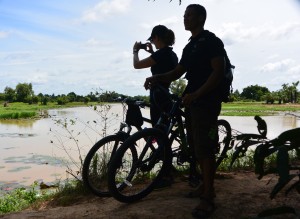 Lors and Zsuzsa looking out over the dam
Lors and Zsuzsa looking out over the dam
Small sandy paths and red earth roads have been usurped by the new Korean ring road that speeds oblivious tourists to Banteay Srei or Citadel of The Woman, North of Angkor. Heads down and legs pumping we ate the Tarmac on our escape from the clutches of tourist town in search of temples.
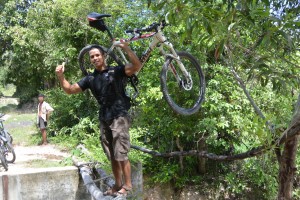 Lors showing off on the rickety bridge
Lors showing off on the rickety bridge
It was cheating slightly as a few weeks back we’d recce’d the ruins on dirt bikes with Dave the helicopter pilot who’d plotted them from the air. Our mission today was to find a path between the ruins and the West Baray, where many of our mountain bike rides finish. Google Earth had made it look easy but I made it hard, leading Lors and Zsuzsa along a track that finished in a ploughed rice field. ‘Boss listen to me, I know the way,’ Lors implored. I didn’t so we followed him and found the first landmark we were looking for, a dam across the Siem Reap river.
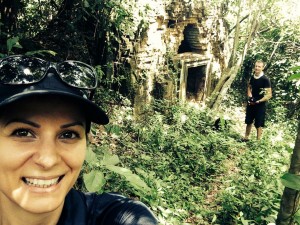 A Zsuzsa selfie with Prasat Sra Laos (and me) in the background
A Zsuzsa selfie with Prasat Sra Laos (and me) in the background
Not really a dam more a muddy earth wall broken by a concrete sluice and a couple of poles that served as a bridge.
A perfect pastoral scene was set in front of us. Farmers tilling their land with buffalo or their mechanical equivalent, kroyun – a sort of hand held tractor. Ladies up to their chest in the small lake formed by the dam gathered lotus flowers until gazing at three barangs cross a rickety bridge became too enticing, especially when one of them, me – fell in.
‘It’s just here Boss.’ Unfortunately Lors was right. I was going to have to pass on my Chief Exploration Officer title. An isolated patch of forest lay in front of us. Zsuzsa and I twisted our way through the tangle of vines and thorny branches into a gloomy clearing surrounding the ancient ruins of Prasat Sra Laos. A conical brick tower on top of a sandstone lintel and doorway. I looked inside to see if there were any bats.
Back at the bikes Lors had made friends with a a couple of happy rice farmers who’d given up on ploughing the paddy fields in favour of rice wine. We zigzag’d our way across the countryside on paths between rice fields, through bush and small patches of forest. Picking up sandy tracks all in vaguely the right direction. ‘How do you know the way Lors? This is amazing!’ I exclaimed. ‘I lucky, just find the right route,’ he glibly smiled (he’d checked out the route the day before).
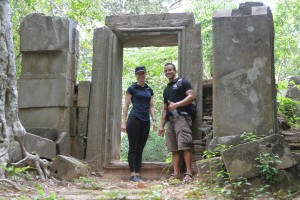 In front of Prasat Cha, Sanscrit is carved into the inside of the stone doorway
In front of Prasat Cha, Sanscrit is carved into the inside of the stone doorway
Tall tree’s are valuable, there’s not many left outside the protection of the Angkor Park. Tall trees near ruins though are inhabited by spirits that are best appeased and not pissed off but cutting their home down. Google can show you where the temple should be but it’s the trees that give away where it is.
Prasat Cha was no exception. Unlike Prasat Sra Laos the shade kept the undestory at bay and created an enchanting glade around the artificial mounds on which Prasat Cha was built. The towers are made of brick & laterite, the doorposts (as shown) of sandstone richly ornamented with Sanskrit inscription, which dates back to the 10th century and Jayavarman V. A lot of what we know today about the Angkorian Empire has been learnt from just such carvings, which while mainly describing the temple and who built it give snippets of fascinating information. Or so I’m told – I don’t read Sanskrit, which is just as well as there’s a local story that tells of a five-headed dragon that confronts anyone who reads.
The rest of our way followed well worn paths we knew well, that is that until we reached a new channel cutting us off from the West Baray. We hoisted the bikes on our shoulders and filed across the big muddy ditch to the walls of the Angkorian Reservoir.
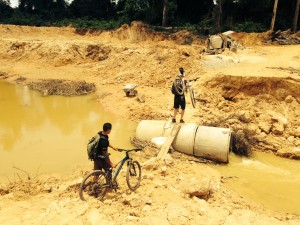 Our last challenge before the Baray.
Our last challenge before the Baray.
Eight by two kilometres with no geographical help from a valley or hill, the West Baray was until the 20th century the largest entirely manmade reservoir in the world built a thousand years ago at the beginning of the 11th Century.
Unfortunately The Amansara Food and Beverage Team were not there to meet us with cold towels and iced lemonade, cold beer and lunch boxes. Instead we made do with lukewarm Kulen water
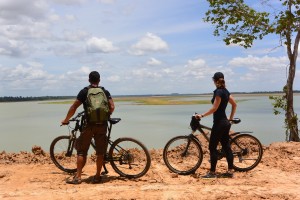 Looking out over the West Baray.
Looking out over the West Baray.
Nick and Buntha are delighted to take guests exploring the local countryside by mountain bike or hiking. Discovering hidden temples where our cold beers and lunch boxes will be waiting.
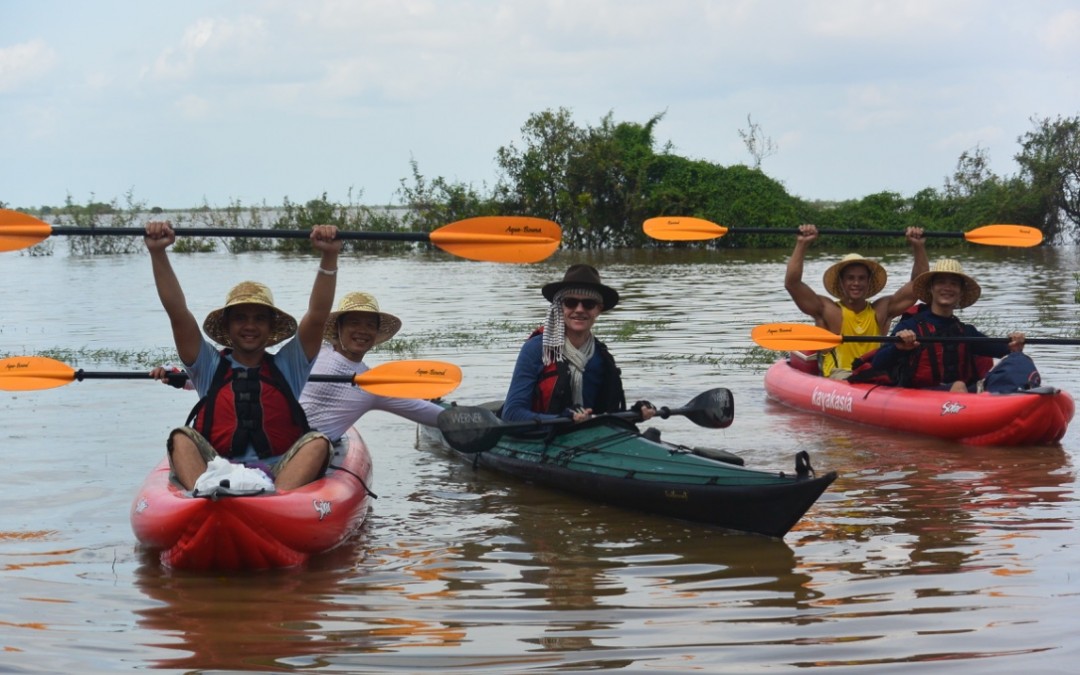
by Nick | Sep 12, 2020 | Blog, Conservation, Kayak
All adventures start with an extra hot latte crafted by Mex at the Little Red Fox Coffee Shop and the morning crew; Jady – temple water management and Darryl the Angkorian historian.
Feathercraft kayak on top of Dy’s electric blue Highlander, Solar kayaks, Lors, Bunthy, Visoth and me inside, another latte then pick up Buntha on the way to the lake.
Our route decided last week when we climbed out of REP Airport on our way to SIN (gapore). Five thousand foot above Phnom Kraum we could see pockets of bush surrounded by a sea of water and not the usual other way round. Direct channels lay clear to the open lake and onto the floating village of Prek Toal.
We launched where the water lapped Phnom Kraum Hill, Bunthy together with Lors, Visoth and Buntha. Laden with dinner and drink, two bladders of wine for the boys and merlot in the cool box for me.
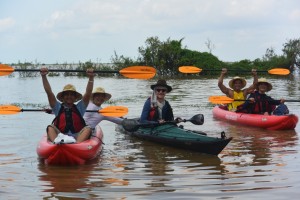
From left to right; Visoth & Buntha, me, Lors and Bunthy
My Werner paddles were so light I barely felt them kissing the water as I effortlessly slid across the lake. The two Solars exploded with muscle like a moon rocket launch then stalled as Bunthy paddled one way and Lors the other. Buntha and Visoth quickly found a rhythm. Fizzing with excitement we set off for Prek Toal.
The lake was not quite so high that we could paddle unimpeded. Lead by lines of vegetation, fishing nets caught in the Solar fins as we zigzagged across the floodplain.
Past midday and Bunthy was running on empty, ‘when are we going to eat?’ He whimpered, while Buntha and Visoth the buffalo paddled on regardless of hunger, fishing lines and fences.
We entered the forest at the edge of the lake and moored to the branches beneath the canopy near the tops of the now submerged trees. We perched on the branches and ate lunch. Lors the gibbon swung from an outlying limb.
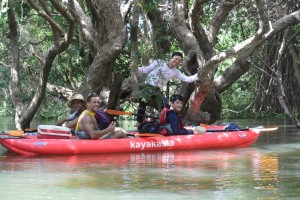
In the canopy forest at the edge of the lake
Climbing down from the tree trunks we made ready for the lake crossing just as the wind died and left barely a ripple on the dull grey expanse of water. The calm made a mockery of my safety briefing. ‘Tie down the equipment, stick together and wear life jackets.’
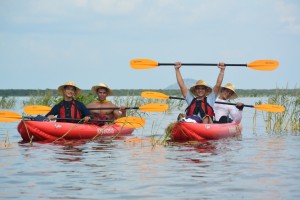
Above and below, Phnom Kraum behind, Prek Toal ahead

Lors inevitably started the horseplay by sitting up on the cool box at the back of his and Bunthy’s kayak nearly capsizing them both. They couldn’t get a rhythm going but his massive muscles powered through despite their lack of technique.
A huge cloud lay heavy over Prek Toal cumulating and shifting like an upset stomach. All the while darkening until the three telephone masts that marked out the village punctured its nebulous vapour releasing a wind that held us stationary and blew off my Akubra hat.
Bunthy and Lors’s calls for five minute breaks were becoming more frequent and faint as Buntha and Visoth, apparently unfatigued paddled on while I just sort of glided.
The whiffs of decomposing fish from the prahoc platforms and the reverberating staccato of the two stroke long-tail engines reached us before we got to the floating shacks at the edge of the village. We paddled between the more substantial houses buoyed up on clumps of bamboo lining the main channel.
Buntha’s pool hall, floating garden, crocodile cages and Mother in Law’s house lay opposite. ‘Do you want a shower Nick? Buntha asked me. ‘Not in your shit!’ The lake was high so well diluted but the crocodiles and Buntha were defecating on one side of the house while the family bathed on the other. I got back in the kayak and paddled away from the village with a bar of soap, managing to wash myself standing on the branches of a submerged tree.
The boys played pool, I scribbled notes then the family emerged from Mother in Law’s house with our dinner. Bunthy had bought plastic skins of cheap vinegary red wine, I’d put a couple of bottles of Chilean merlot in the cool box, which rapidly disappeared when Buntha found out how much nicer they tasted. We finished dinner. The alcohol combined with the day’s exercise, rounded off by five mg of Valium left me contentedly numbed. I turned off the Mother in Law’s radio lay down next to the crocodiles and fell asleep.
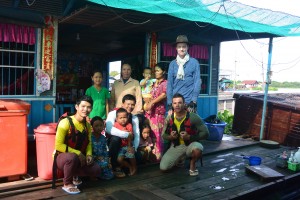
Saying goodbye to Buntha’s Family (excluding the Mother in Law)
A horrific fire had burned for day’s leaving half of the Core Bird Reserve reduced to charcoal. We paddled between the blackened branches saddened. The irrepressible Lors quickly diverted our attention and the presence of any wildlife with the continual noise he emitted.
The fire was an environmental disaster but still the floodplain is a wonderful and alien world of water and blissful quiet, excepting Lors.
Dy was waiting with his ice cold Highlander at Maichrey. It was past noon so rice was the priority. We diverted via the Baray now swollen with rain and a bamboo platform over the water for road kill chicken rice and tamarind paste, a look of total exhaustion on the boy’s faces. It had been fun!
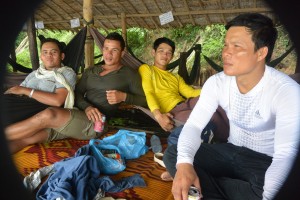
Exhausted waiting for lunch at the West Baray
We are very pleased to take our guests on a day trip by motorboat to the floating village of Prek Toal with an early morning boat journey in the seasonally flooded forests of The Core Bird Reserve. On the return we explore the village by kayak with lunch on a floating platform then paddle to Buntha’s house and meet his family (and crocodiles).
If you have a bit more time an overnight stay means you start to get a glimpse of what life on the lake is really like. And we’d be delighted to paddle with you all the way if you’re up for the challenge!

 Setting off on The Kulen Trail with Buntha, Nai & John
Setting off on The Kulen Trail with Buntha, Nai & John Sra Domrey a VIV century Hindu carving
Sra Domrey a VIV century Hindu carving Our Campsite beside the Kulen River
Our Campsite beside the Kulen River A forest giant
A forest giant Mushroom Rock in the boulder forest (actually taken by camera trap capturing not only the Silver Langurs but also Pig-tailed Macaque)
Mushroom Rock in the boulder forest (actually taken by camera trap capturing not only the Silver Langurs but also Pig-tailed Macaque) A forest of lianas on the way to Preah Ang Chup
A forest of lianas on the way to Preah Ang Chup The steps up to Preah Ang Chup, the only entry point to Kulen until early 20th century (compare the current concrete domreys with their Angkorian cousin in the forest)
The steps up to Preah Ang Chup, the only entry point to Kulen until early 20th century (compare the current concrete domreys with their Angkorian cousin in the forest)

 Loklak checking out the temple trail
Loklak checking out the temple trail Manus framed by Phnom Bok and it’s lake
Manus framed by Phnom Bok and it’s lake
 Prasat Toh
Prasat Toh Angkorian demon (left) and Oxcart (below)
Angkorian demon (left) and Oxcart (below)
 Phum Samre Market
Phum Samre Market Chinese New Year Flower
Chinese New Year Flower Pradark Pagoda
Pradark Pagoda Prasat Kamnap
Prasat Kamnap
 Rehydrating Loklak
Rehydrating Loklak A beer beside the baray
A beer beside the baray
 Lake Ta Neue
Lake Ta Neue A monk’s house at Pradark Pagoda
A monk’s house at Pradark Pagoda Prasat Kom Nat
Prasat Kom Nat View of the Baray from the East bank
View of the Baray from the East bank The village of Pum Samre
The village of Pum Samre Prasat Tor
Prasat Tor The launch committee
The launch committee Cast net fishermen (and a dog)
Cast net fishermen (and a dog) Num ban Chok in Pradark
Num ban Chok in Pradark
 Lors and Zsuzsa looking out over the dam
Lors and Zsuzsa looking out over the dam Lors showing off on the rickety bridge
Lors showing off on the rickety bridge A Zsuzsa selfie with Prasat Sra Laos (and me) in the background
A Zsuzsa selfie with Prasat Sra Laos (and me) in the background In front of Prasat Cha, Sanscrit is carved into the inside of the stone doorway
In front of Prasat Cha, Sanscrit is carved into the inside of the stone doorway Our last challenge before the Baray.
Our last challenge before the Baray. Looking out over the West Baray.
Looking out over the West Baray.





